Report: Accounting Framework, Australian Standards, and Amcor Ltd
VerifiedAdded on 2023/01/24
|21
|4018
|58
Report
AI Summary
This report provides an in-depth analysis of the accounting framework, with a specific focus on Amcor Ltd and its adherence to Australian accounting standards. It begins with an executive summary outlining the report's objectives and then delves into the importance of accounting standards in financial reporting. The discussion covers theoretical models of accounting, the role of the Australian Accounting Standards Board (AASB), and the theoretical constructs of contemporary financial accounting. The report highlights the need for a conceptual framework in accounting and examines its influence on the development of consistent accounting practices. It further explores specific accounting topics such as non-current assets, liabilities, revaluation, impairments, and accounting for leases. The report concludes by summarizing the key findings and emphasizing the significance of a well-defined accounting framework for ensuring transparency and reliability in financial reporting. The document is contributed by a student to be published on the website Desklib, a platform which provides all the necessary AI based study tools for students.
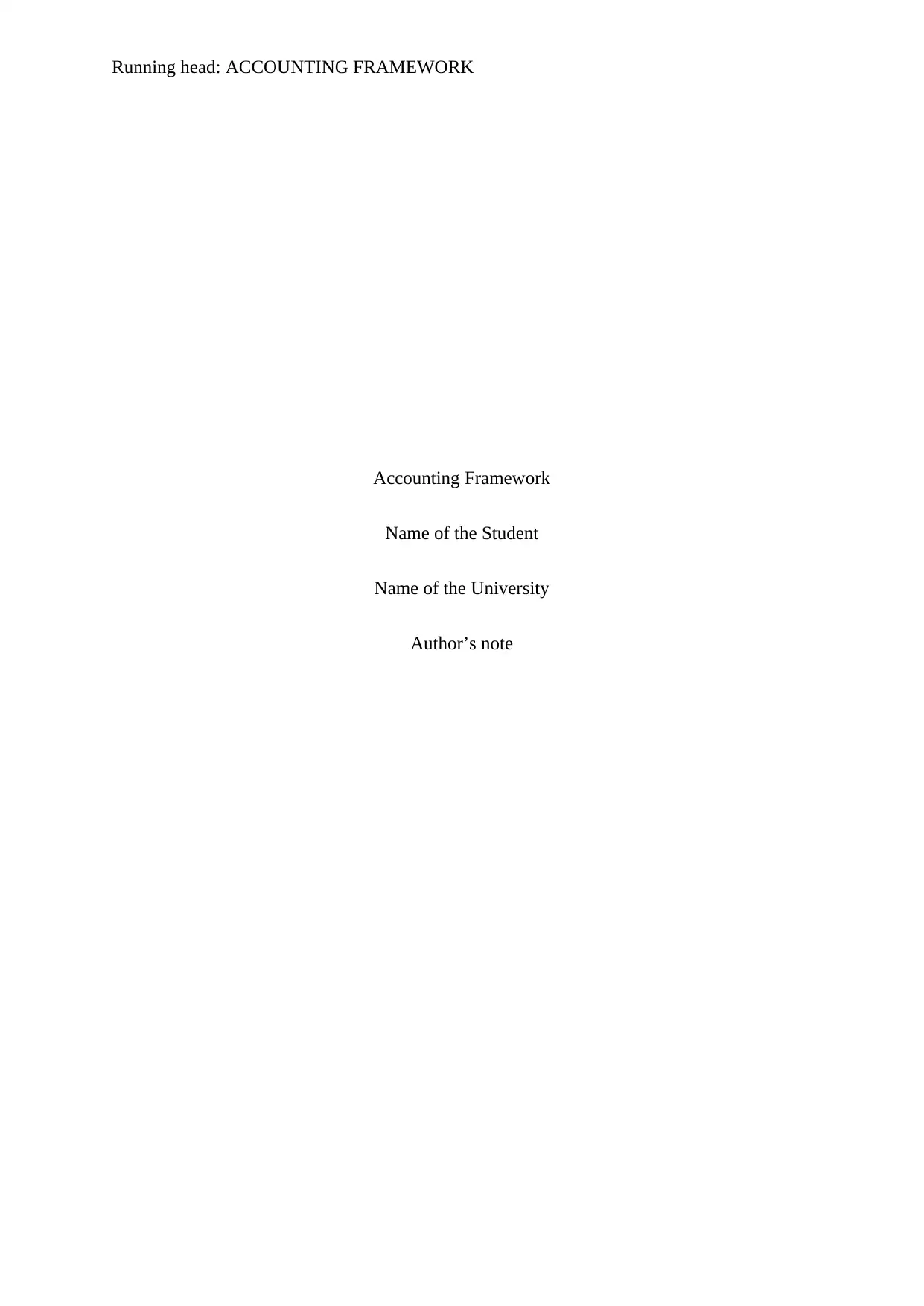
Running head: ACCOUNTING FRAMEWORK
Accounting Framework
Name of the Student
Name of the University
Author’s note
Accounting Framework
Name of the Student
Name of the University
Author’s note
Paraphrase This Document
Need a fresh take? Get an instant paraphrase of this document with our AI Paraphraser
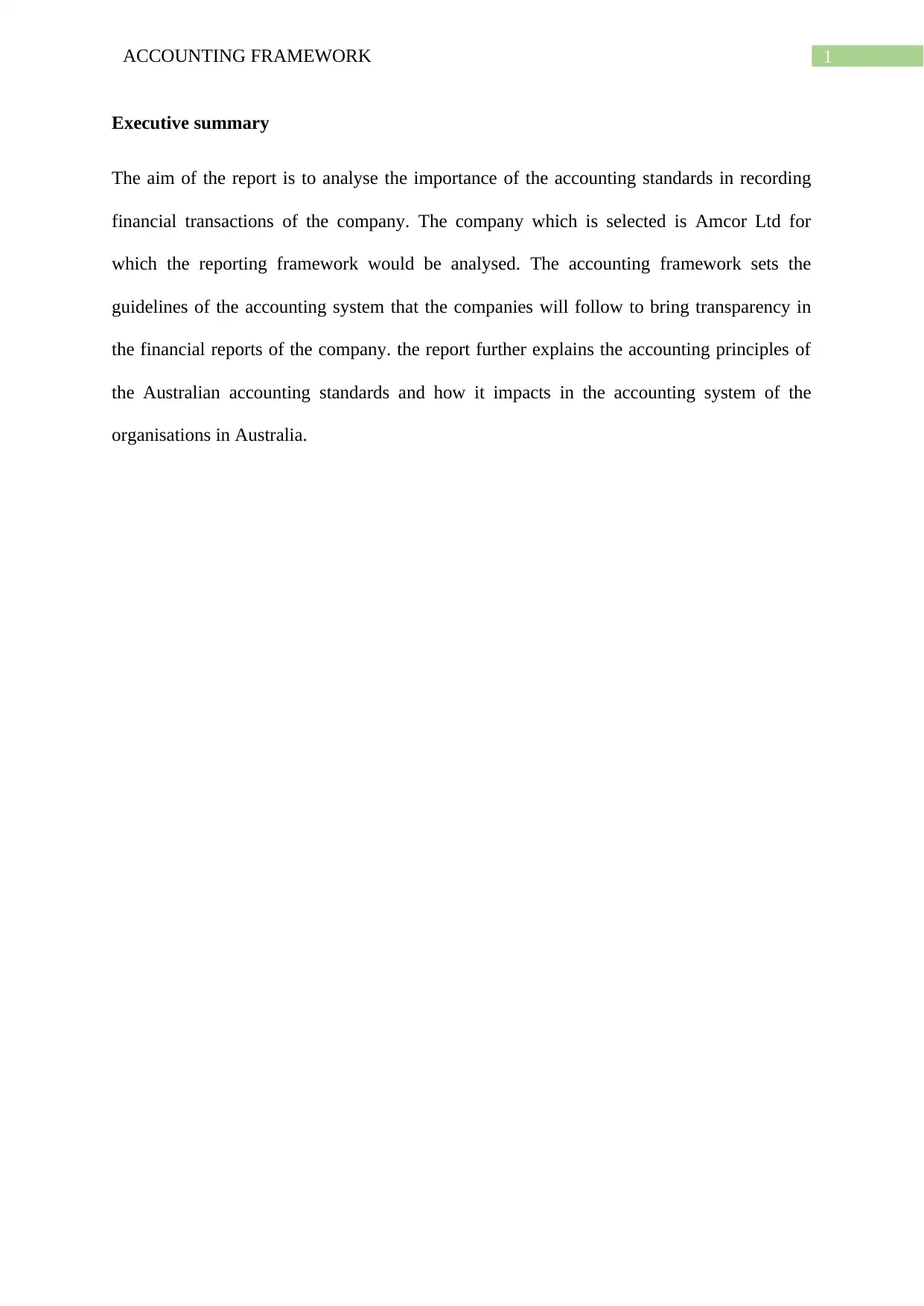
1ACCOUNTING FRAMEWORK
Executive summary
The aim of the report is to analyse the importance of the accounting standards in recording
financial transactions of the company. The company which is selected is Amcor Ltd for
which the reporting framework would be analysed. The accounting framework sets the
guidelines of the accounting system that the companies will follow to bring transparency in
the financial reports of the company. the report further explains the accounting principles of
the Australian accounting standards and how it impacts in the accounting system of the
organisations in Australia.
Executive summary
The aim of the report is to analyse the importance of the accounting standards in recording
financial transactions of the company. The company which is selected is Amcor Ltd for
which the reporting framework would be analysed. The accounting framework sets the
guidelines of the accounting system that the companies will follow to bring transparency in
the financial reports of the company. the report further explains the accounting principles of
the Australian accounting standards and how it impacts in the accounting system of the
organisations in Australia.
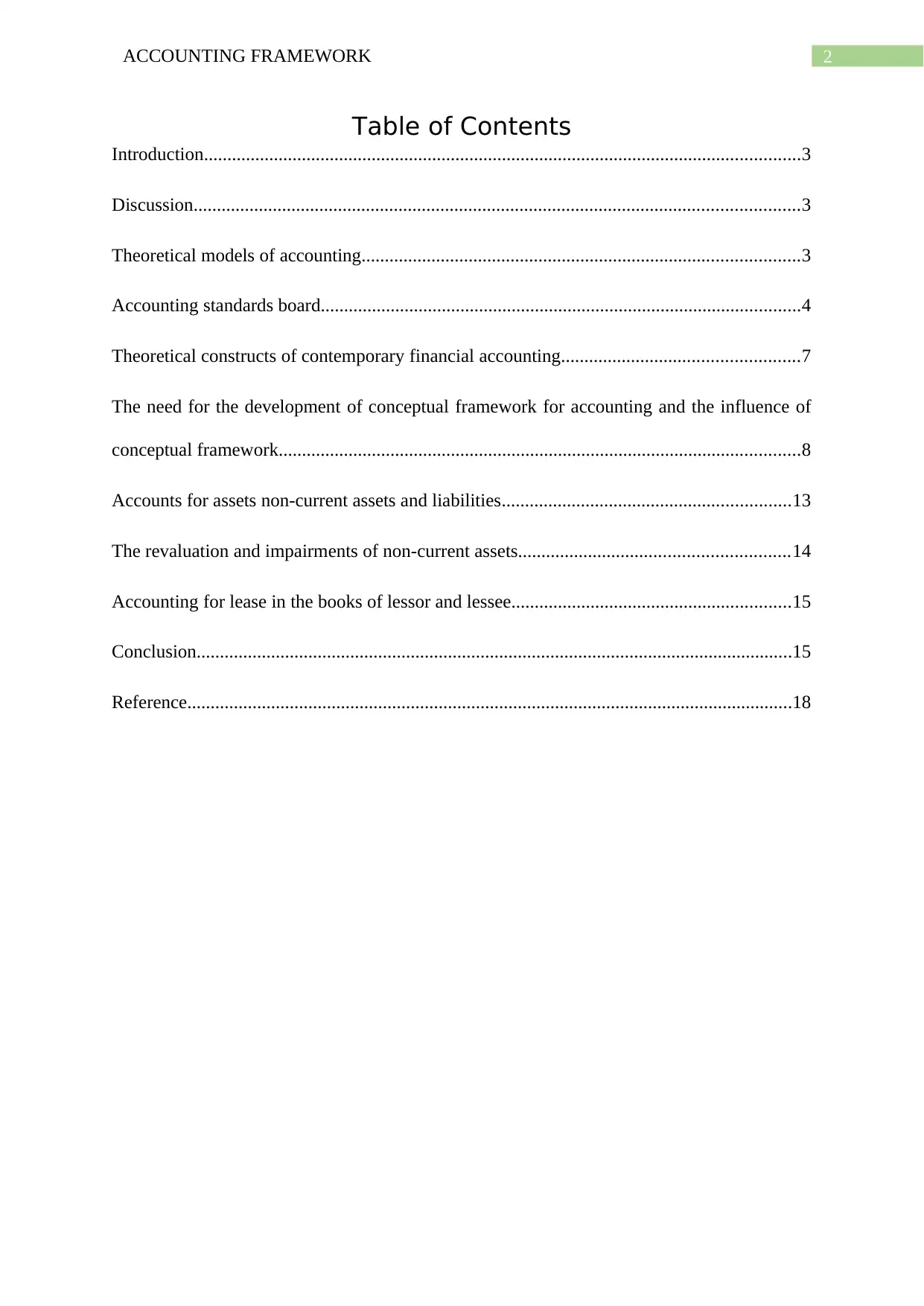
2ACCOUNTING FRAMEWORK
Table of Contents
Introduction................................................................................................................................3
Discussion..................................................................................................................................3
Theoretical models of accounting..............................................................................................3
Accounting standards board.......................................................................................................4
Theoretical constructs of contemporary financial accounting...................................................7
The need for the development of conceptual framework for accounting and the influence of
conceptual framework................................................................................................................8
Accounts for assets non-current assets and liabilities..............................................................13
The revaluation and impairments of non-current assets..........................................................14
Accounting for lease in the books of lessor and lessee............................................................15
Conclusion................................................................................................................................15
Reference..................................................................................................................................18
Table of Contents
Introduction................................................................................................................................3
Discussion..................................................................................................................................3
Theoretical models of accounting..............................................................................................3
Accounting standards board.......................................................................................................4
Theoretical constructs of contemporary financial accounting...................................................7
The need for the development of conceptual framework for accounting and the influence of
conceptual framework................................................................................................................8
Accounts for assets non-current assets and liabilities..............................................................13
The revaluation and impairments of non-current assets..........................................................14
Accounting for lease in the books of lessor and lessee............................................................15
Conclusion................................................................................................................................15
Reference..................................................................................................................................18
⊘ This is a preview!⊘
Do you want full access?
Subscribe today to unlock all pages.

Trusted by 1+ million students worldwide
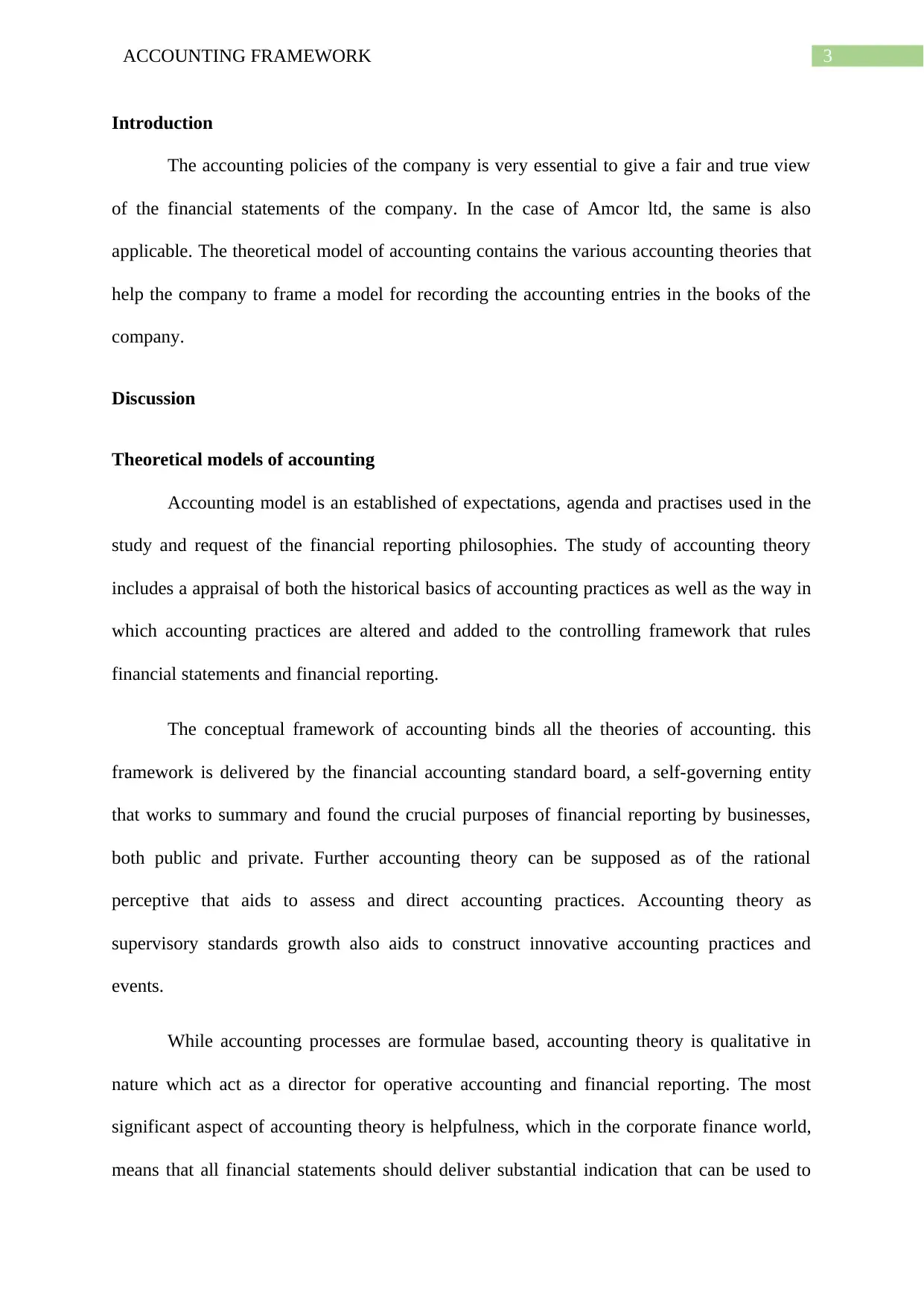
3ACCOUNTING FRAMEWORK
Introduction
The accounting policies of the company is very essential to give a fair and true view
of the financial statements of the company. In the case of Amcor ltd, the same is also
applicable. The theoretical model of accounting contains the various accounting theories that
help the company to frame a model for recording the accounting entries in the books of the
company.
Discussion
Theoretical models of accounting
Accounting model is an established of expectations, agenda and practises used in the
study and request of the financial reporting philosophies. The study of accounting theory
includes a appraisal of both the historical basics of accounting practices as well as the way in
which accounting practices are altered and added to the controlling framework that rules
financial statements and financial reporting.
The conceptual framework of accounting binds all the theories of accounting. this
framework is delivered by the financial accounting standard board, a self-governing entity
that works to summary and found the crucial purposes of financial reporting by businesses,
both public and private. Further accounting theory can be supposed as of the rational
perceptive that aids to assess and direct accounting practices. Accounting theory as
supervisory standards growth also aids to construct innovative accounting practices and
events.
While accounting processes are formulae based, accounting theory is qualitative in
nature which act as a director for operative accounting and financial reporting. The most
significant aspect of accounting theory is helpfulness, which in the corporate finance world,
means that all financial statements should deliver substantial indication that can be used to
Introduction
The accounting policies of the company is very essential to give a fair and true view
of the financial statements of the company. In the case of Amcor ltd, the same is also
applicable. The theoretical model of accounting contains the various accounting theories that
help the company to frame a model for recording the accounting entries in the books of the
company.
Discussion
Theoretical models of accounting
Accounting model is an established of expectations, agenda and practises used in the
study and request of the financial reporting philosophies. The study of accounting theory
includes a appraisal of both the historical basics of accounting practices as well as the way in
which accounting practices are altered and added to the controlling framework that rules
financial statements and financial reporting.
The conceptual framework of accounting binds all the theories of accounting. this
framework is delivered by the financial accounting standard board, a self-governing entity
that works to summary and found the crucial purposes of financial reporting by businesses,
both public and private. Further accounting theory can be supposed as of the rational
perceptive that aids to assess and direct accounting practices. Accounting theory as
supervisory standards growth also aids to construct innovative accounting practices and
events.
While accounting processes are formulae based, accounting theory is qualitative in
nature which act as a director for operative accounting and financial reporting. The most
significant aspect of accounting theory is helpfulness, which in the corporate finance world,
means that all financial statements should deliver substantial indication that can be used to
Paraphrase This Document
Need a fresh take? Get an instant paraphrase of this document with our AI Paraphraser
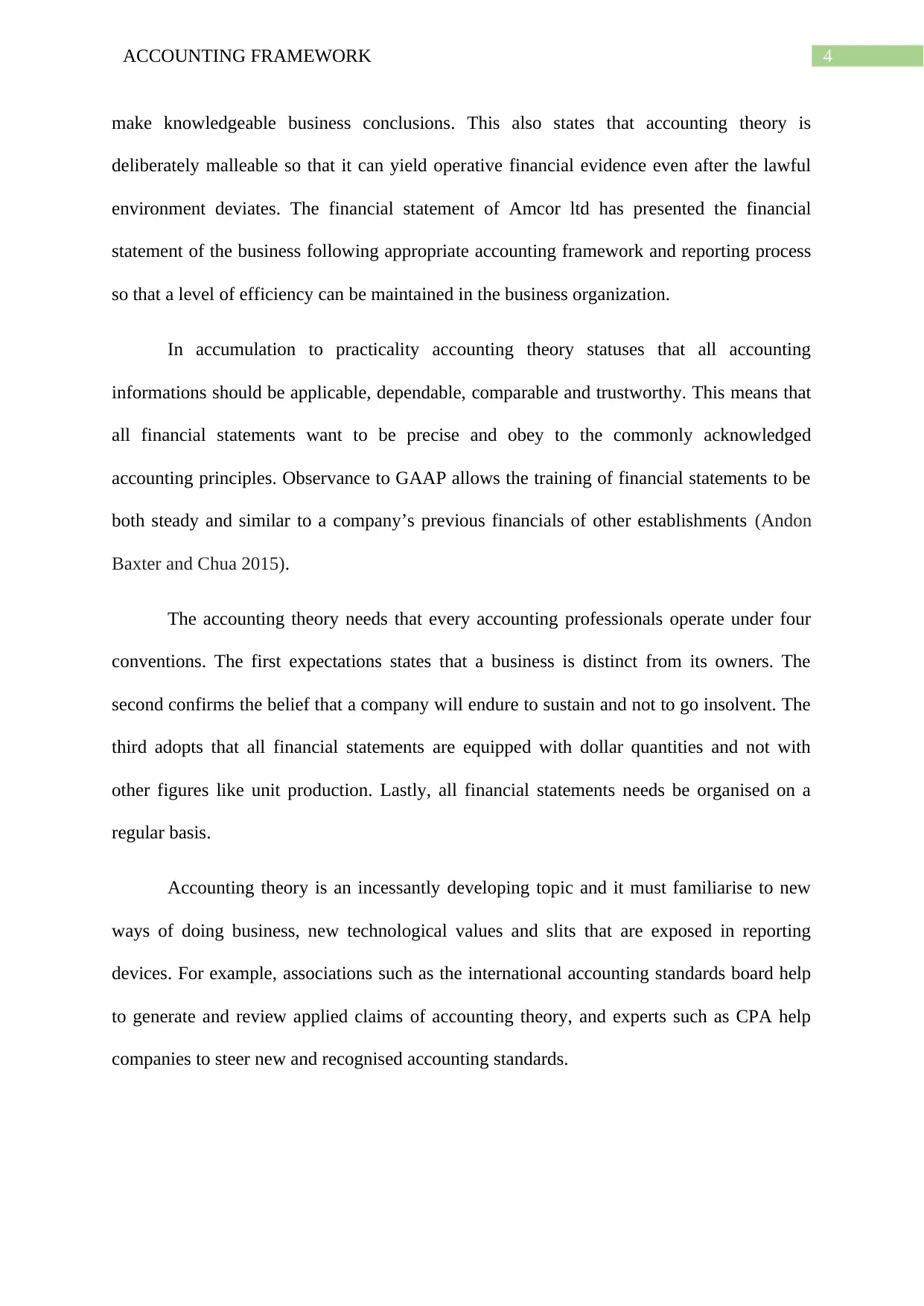
4ACCOUNTING FRAMEWORK
make knowledgeable business conclusions. This also states that accounting theory is
deliberately malleable so that it can yield operative financial evidence even after the lawful
environment deviates. The financial statement of Amcor ltd has presented the financial
statement of the business following appropriate accounting framework and reporting process
so that a level of efficiency can be maintained in the business organization.
In accumulation to practicality accounting theory statuses that all accounting
informations should be applicable, dependable, comparable and trustworthy. This means that
all financial statements want to be precise and obey to the commonly acknowledged
accounting principles. Observance to GAAP allows the training of financial statements to be
both steady and similar to a company’s previous financials of other establishments (Andon
Baxter and Chua 2015).
The accounting theory needs that every accounting professionals operate under four
conventions. The first expectations states that a business is distinct from its owners. The
second confirms the belief that a company will endure to sustain and not to go insolvent. The
third adopts that all financial statements are equipped with dollar quantities and not with
other figures like unit production. Lastly, all financial statements needs be organised on a
regular basis.
Accounting theory is an incessantly developing topic and it must familiarise to new
ways of doing business, new technological values and slits that are exposed in reporting
devices. For example, associations such as the international accounting standards board help
to generate and review applied claims of accounting theory, and experts such as CPA help
companies to steer new and recognised accounting standards.
make knowledgeable business conclusions. This also states that accounting theory is
deliberately malleable so that it can yield operative financial evidence even after the lawful
environment deviates. The financial statement of Amcor ltd has presented the financial
statement of the business following appropriate accounting framework and reporting process
so that a level of efficiency can be maintained in the business organization.
In accumulation to practicality accounting theory statuses that all accounting
informations should be applicable, dependable, comparable and trustworthy. This means that
all financial statements want to be precise and obey to the commonly acknowledged
accounting principles. Observance to GAAP allows the training of financial statements to be
both steady and similar to a company’s previous financials of other establishments (Andon
Baxter and Chua 2015).
The accounting theory needs that every accounting professionals operate under four
conventions. The first expectations states that a business is distinct from its owners. The
second confirms the belief that a company will endure to sustain and not to go insolvent. The
third adopts that all financial statements are equipped with dollar quantities and not with
other figures like unit production. Lastly, all financial statements needs be organised on a
regular basis.
Accounting theory is an incessantly developing topic and it must familiarise to new
ways of doing business, new technological values and slits that are exposed in reporting
devices. For example, associations such as the international accounting standards board help
to generate and review applied claims of accounting theory, and experts such as CPA help
companies to steer new and recognised accounting standards.
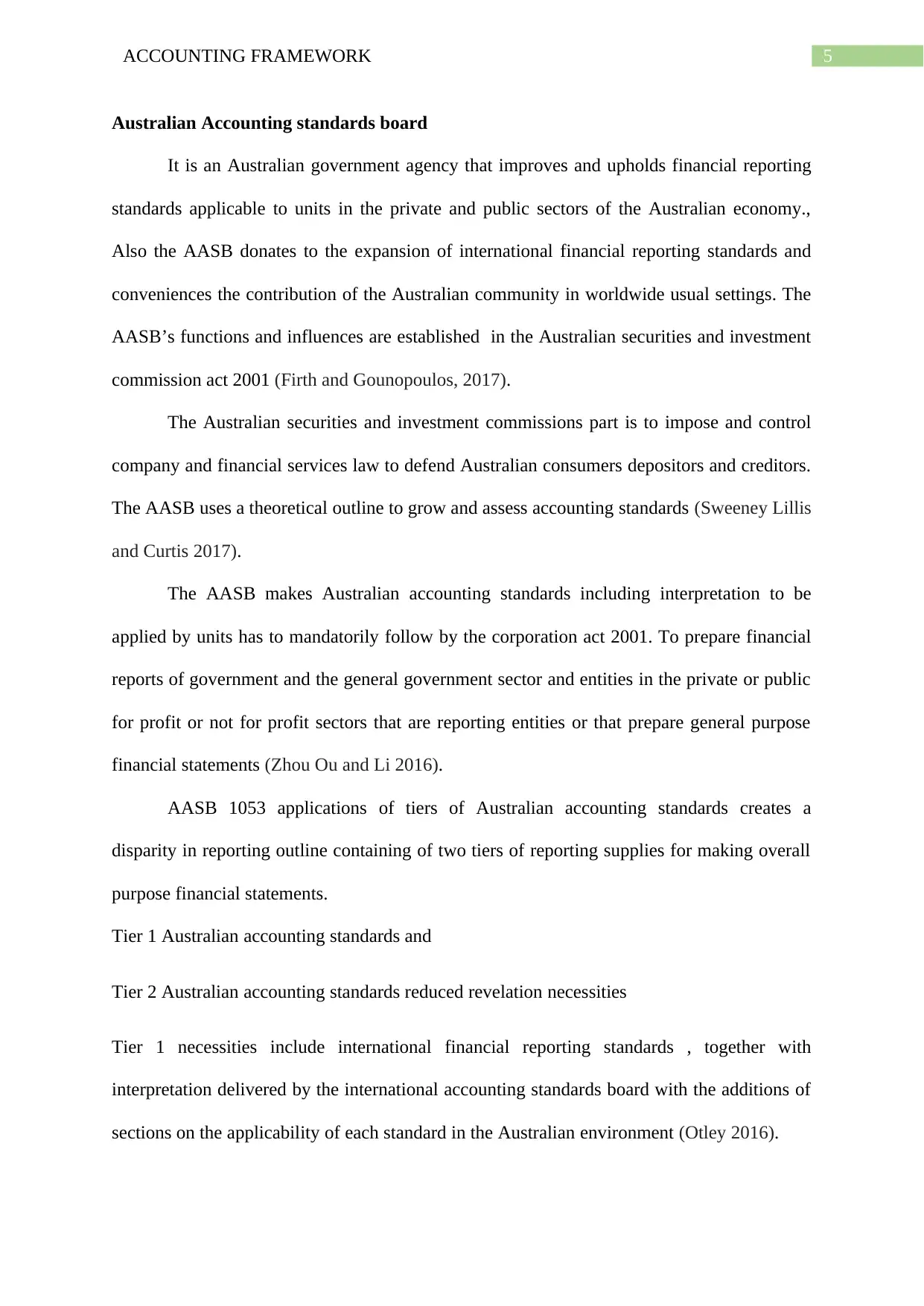
5ACCOUNTING FRAMEWORK
Australian Accounting standards board
It is an Australian government agency that improves and upholds financial reporting
standards applicable to units in the private and public sectors of the Australian economy.,
Also the AASB donates to the expansion of international financial reporting standards and
conveniences the contribution of the Australian community in worldwide usual settings. The
AASB’s functions and influences are established in the Australian securities and investment
commission act 2001 (Firth and Gounopoulos, 2017).
The Australian securities and investment commissions part is to impose and control
company and financial services law to defend Australian consumers depositors and creditors.
The AASB uses a theoretical outline to grow and assess accounting standards (Sweeney Lillis
and Curtis 2017).
The AASB makes Australian accounting standards including interpretation to be
applied by units has to mandatorily follow by the corporation act 2001. To prepare financial
reports of government and the general government sector and entities in the private or public
for profit or not for profit sectors that are reporting entities or that prepare general purpose
financial statements (Zhou Ou and Li 2016).
AASB 1053 applications of tiers of Australian accounting standards creates a
disparity in reporting outline containing of two tiers of reporting supplies for making overall
purpose financial statements.
Tier 1 Australian accounting standards and
Tier 2 Australian accounting standards reduced revelation necessities
Tier 1 necessities include international financial reporting standards , together with
interpretation delivered by the international accounting standards board with the additions of
sections on the applicability of each standard in the Australian environment (Otley 2016).
Australian Accounting standards board
It is an Australian government agency that improves and upholds financial reporting
standards applicable to units in the private and public sectors of the Australian economy.,
Also the AASB donates to the expansion of international financial reporting standards and
conveniences the contribution of the Australian community in worldwide usual settings. The
AASB’s functions and influences are established in the Australian securities and investment
commission act 2001 (Firth and Gounopoulos, 2017).
The Australian securities and investment commissions part is to impose and control
company and financial services law to defend Australian consumers depositors and creditors.
The AASB uses a theoretical outline to grow and assess accounting standards (Sweeney Lillis
and Curtis 2017).
The AASB makes Australian accounting standards including interpretation to be
applied by units has to mandatorily follow by the corporation act 2001. To prepare financial
reports of government and the general government sector and entities in the private or public
for profit or not for profit sectors that are reporting entities or that prepare general purpose
financial statements (Zhou Ou and Li 2016).
AASB 1053 applications of tiers of Australian accounting standards creates a
disparity in reporting outline containing of two tiers of reporting supplies for making overall
purpose financial statements.
Tier 1 Australian accounting standards and
Tier 2 Australian accounting standards reduced revelation necessities
Tier 1 necessities include international financial reporting standards , together with
interpretation delivered by the international accounting standards board with the additions of
sections on the applicability of each standard in the Australian environment (Otley 2016).
⊘ This is a preview!⊘
Do you want full access?
Subscribe today to unlock all pages.

Trusted by 1+ million students worldwide
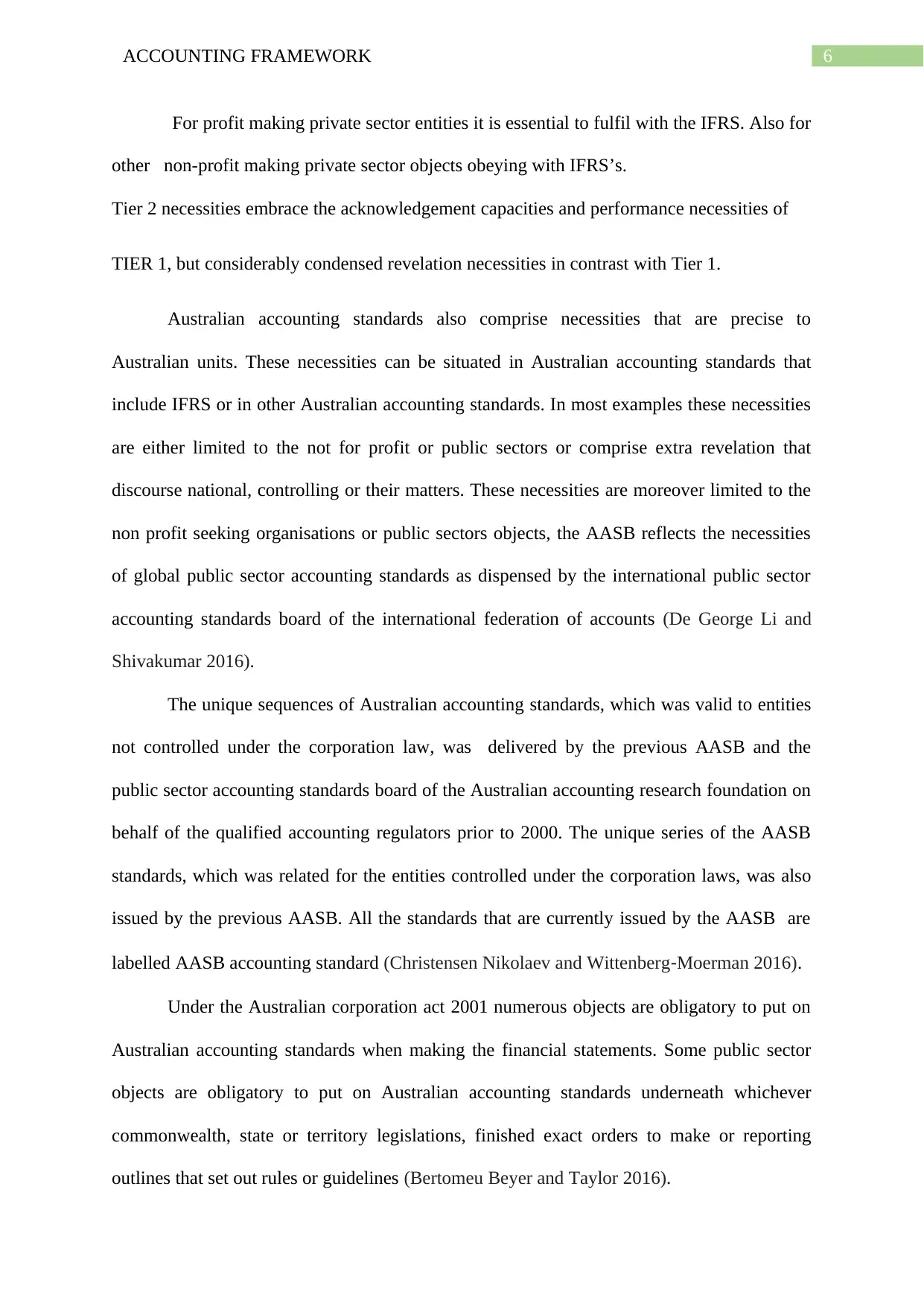
6ACCOUNTING FRAMEWORK
For profit making private sector entities it is essential to fulfil with the IFRS. Also for
other non-profit making private sector objects obeying with IFRS’s.
Tier 2 necessities embrace the acknowledgement capacities and performance necessities of
TIER 1, but considerably condensed revelation necessities in contrast with Tier 1.
Australian accounting standards also comprise necessities that are precise to
Australian units. These necessities can be situated in Australian accounting standards that
include IFRS or in other Australian accounting standards. In most examples these necessities
are either limited to the not for profit or public sectors or comprise extra revelation that
discourse national, controlling or their matters. These necessities are moreover limited to the
non profit seeking organisations or public sectors objects, the AASB reflects the necessities
of global public sector accounting standards as dispensed by the international public sector
accounting standards board of the international federation of accounts (De George Li and
Shivakumar 2016).
The unique sequences of Australian accounting standards, which was valid to entities
not controlled under the corporation law, was delivered by the previous AASB and the
public sector accounting standards board of the Australian accounting research foundation on
behalf of the qualified accounting regulators prior to 2000. The unique series of the AASB
standards, which was related for the entities controlled under the corporation laws, was also
issued by the previous AASB. All the standards that are currently issued by the AASB are
labelled AASB accounting standard (Christensen Nikolaev and Wittenberg‐Moerman 2016).
Under the Australian corporation act 2001 numerous objects are obligatory to put on
Australian accounting standards when making the financial statements. Some public sector
objects are obligatory to put on Australian accounting standards underneath whichever
commonwealth, state or territory legislations, finished exact orders to make or reporting
outlines that set out rules or guidelines (Bertomeu Beyer and Taylor 2016).
For profit making private sector entities it is essential to fulfil with the IFRS. Also for
other non-profit making private sector objects obeying with IFRS’s.
Tier 2 necessities embrace the acknowledgement capacities and performance necessities of
TIER 1, but considerably condensed revelation necessities in contrast with Tier 1.
Australian accounting standards also comprise necessities that are precise to
Australian units. These necessities can be situated in Australian accounting standards that
include IFRS or in other Australian accounting standards. In most examples these necessities
are either limited to the not for profit or public sectors or comprise extra revelation that
discourse national, controlling or their matters. These necessities are moreover limited to the
non profit seeking organisations or public sectors objects, the AASB reflects the necessities
of global public sector accounting standards as dispensed by the international public sector
accounting standards board of the international federation of accounts (De George Li and
Shivakumar 2016).
The unique sequences of Australian accounting standards, which was valid to entities
not controlled under the corporation law, was delivered by the previous AASB and the
public sector accounting standards board of the Australian accounting research foundation on
behalf of the qualified accounting regulators prior to 2000. The unique series of the AASB
standards, which was related for the entities controlled under the corporation laws, was also
issued by the previous AASB. All the standards that are currently issued by the AASB are
labelled AASB accounting standard (Christensen Nikolaev and Wittenberg‐Moerman 2016).
Under the Australian corporation act 2001 numerous objects are obligatory to put on
Australian accounting standards when making the financial statements. Some public sector
objects are obligatory to put on Australian accounting standards underneath whichever
commonwealth, state or territory legislations, finished exact orders to make or reporting
outlines that set out rules or guidelines (Bertomeu Beyer and Taylor 2016).
Paraphrase This Document
Need a fresh take? Get an instant paraphrase of this document with our AI Paraphraser
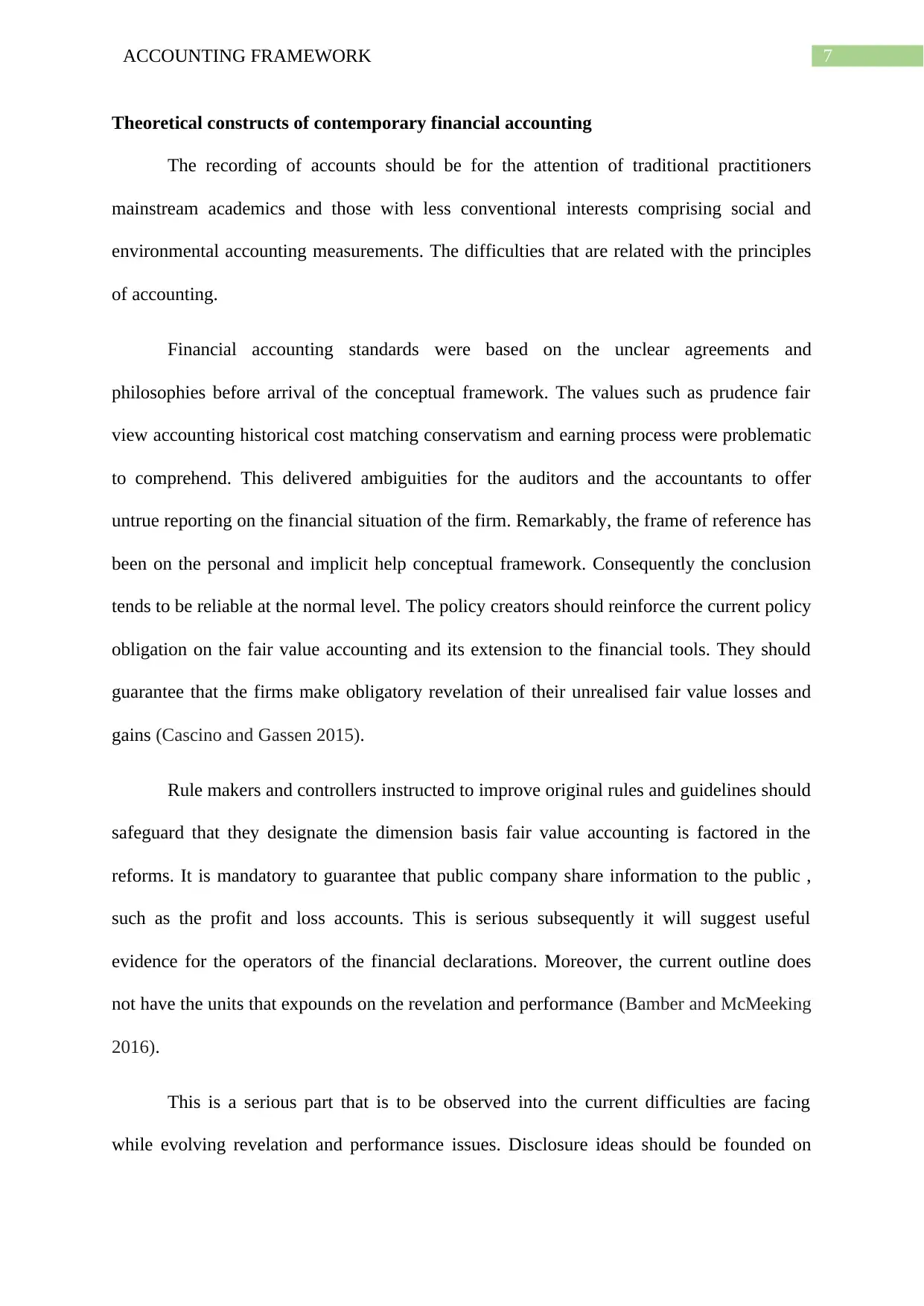
7ACCOUNTING FRAMEWORK
Theoretical constructs of contemporary financial accounting
The recording of accounts should be for the attention of traditional practitioners
mainstream academics and those with less conventional interests comprising social and
environmental accounting measurements. The difficulties that are related with the principles
of accounting.
Financial accounting standards were based on the unclear agreements and
philosophies before arrival of the conceptual framework. The values such as prudence fair
view accounting historical cost matching conservatism and earning process were problematic
to comprehend. This delivered ambiguities for the auditors and the accountants to offer
untrue reporting on the financial situation of the firm. Remarkably, the frame of reference has
been on the personal and implicit help conceptual framework. Consequently the conclusion
tends to be reliable at the normal level. The policy creators should reinforce the current policy
obligation on the fair value accounting and its extension to the financial tools. They should
guarantee that the firms make obligatory revelation of their unrealised fair value losses and
gains (Cascino and Gassen 2015).
Rule makers and controllers instructed to improve original rules and guidelines should
safeguard that they designate the dimension basis fair value accounting is factored in the
reforms. It is mandatory to guarantee that public company share information to the public ,
such as the profit and loss accounts. This is serious subsequently it will suggest useful
evidence for the operators of the financial declarations. Moreover, the current outline does
not have the units that expounds on the revelation and performance (Bamber and McMeeking
2016).
This is a serious part that is to be observed into the current difficulties are facing
while evolving revelation and performance issues. Disclosure ideas should be founded on
Theoretical constructs of contemporary financial accounting
The recording of accounts should be for the attention of traditional practitioners
mainstream academics and those with less conventional interests comprising social and
environmental accounting measurements. The difficulties that are related with the principles
of accounting.
Financial accounting standards were based on the unclear agreements and
philosophies before arrival of the conceptual framework. The values such as prudence fair
view accounting historical cost matching conservatism and earning process were problematic
to comprehend. This delivered ambiguities for the auditors and the accountants to offer
untrue reporting on the financial situation of the firm. Remarkably, the frame of reference has
been on the personal and implicit help conceptual framework. Consequently the conclusion
tends to be reliable at the normal level. The policy creators should reinforce the current policy
obligation on the fair value accounting and its extension to the financial tools. They should
guarantee that the firms make obligatory revelation of their unrealised fair value losses and
gains (Cascino and Gassen 2015).
Rule makers and controllers instructed to improve original rules and guidelines should
safeguard that they designate the dimension basis fair value accounting is factored in the
reforms. It is mandatory to guarantee that public company share information to the public ,
such as the profit and loss accounts. This is serious subsequently it will suggest useful
evidence for the operators of the financial declarations. Moreover, the current outline does
not have the units that expounds on the revelation and performance (Bamber and McMeeking
2016).
This is a serious part that is to be observed into the current difficulties are facing
while evolving revelation and performance issues. Disclosure ideas should be founded on
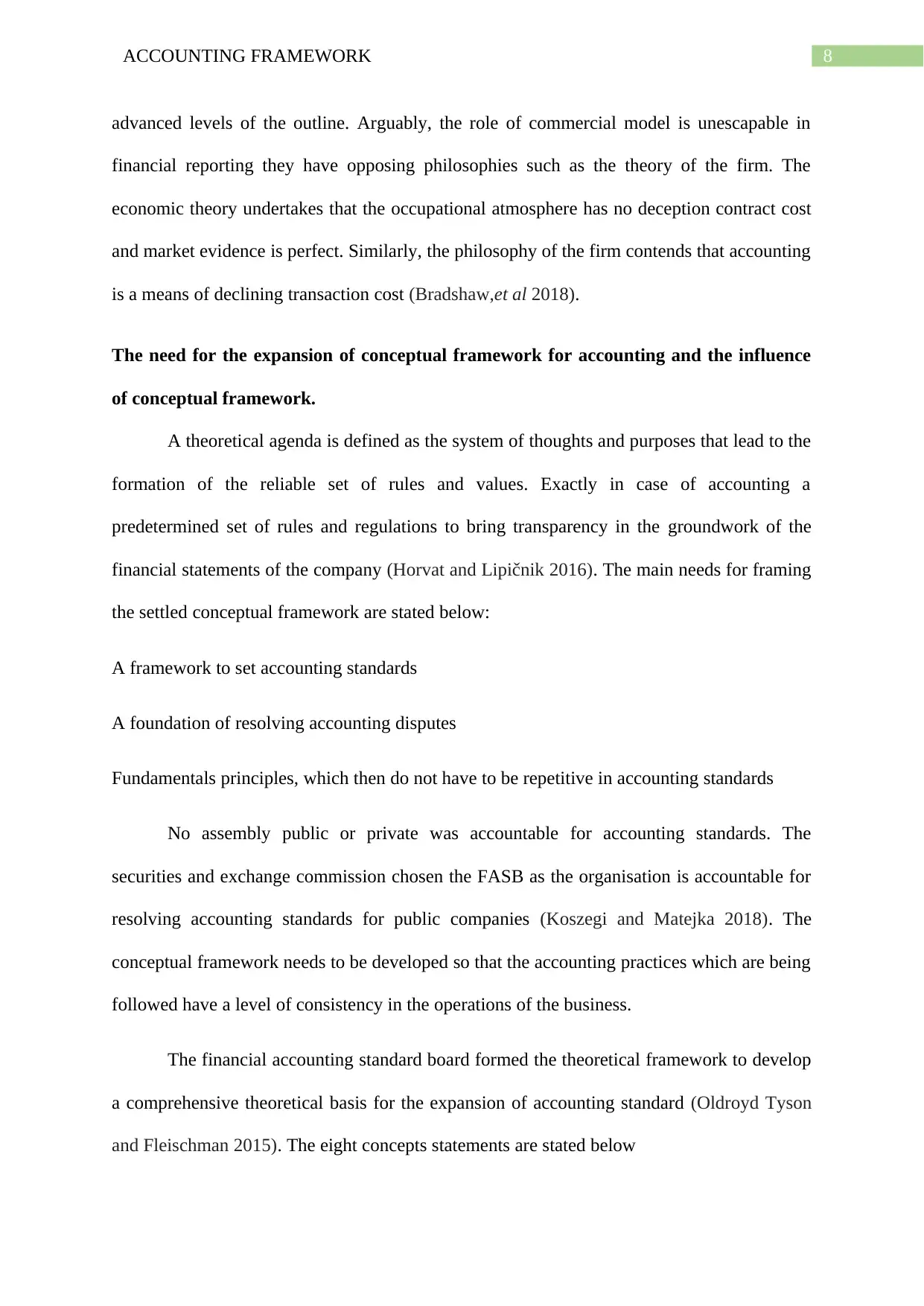
8ACCOUNTING FRAMEWORK
advanced levels of the outline. Arguably, the role of commercial model is unescapable in
financial reporting they have opposing philosophies such as the theory of the firm. The
economic theory undertakes that the occupational atmosphere has no deception contract cost
and market evidence is perfect. Similarly, the philosophy of the firm contends that accounting
is a means of declining transaction cost (Bradshaw,et al 2018).
The need for the expansion of conceptual framework for accounting and the influence
of conceptual framework.
A theoretical agenda is defined as the system of thoughts and purposes that lead to the
formation of the reliable set of rules and values. Exactly in case of accounting a
predetermined set of rules and regulations to bring transparency in the groundwork of the
financial statements of the company (Horvat and Lipičnik 2016). The main needs for framing
the settled conceptual framework are stated below:
A framework to set accounting standards
A foundation of resolving accounting disputes
Fundamentals principles, which then do not have to be repetitive in accounting standards
No assembly public or private was accountable for accounting standards. The
securities and exchange commission chosen the FASB as the organisation is accountable for
resolving accounting standards for public companies (Koszegi and Matejka 2018). The
conceptual framework needs to be developed so that the accounting practices which are being
followed have a level of consistency in the operations of the business.
The financial accounting standard board formed the theoretical framework to develop
a comprehensive theoretical basis for the expansion of accounting standard (Oldroyd Tyson
and Fleischman 2015). The eight concepts statements are stated below
advanced levels of the outline. Arguably, the role of commercial model is unescapable in
financial reporting they have opposing philosophies such as the theory of the firm. The
economic theory undertakes that the occupational atmosphere has no deception contract cost
and market evidence is perfect. Similarly, the philosophy of the firm contends that accounting
is a means of declining transaction cost (Bradshaw,et al 2018).
The need for the expansion of conceptual framework for accounting and the influence
of conceptual framework.
A theoretical agenda is defined as the system of thoughts and purposes that lead to the
formation of the reliable set of rules and values. Exactly in case of accounting a
predetermined set of rules and regulations to bring transparency in the groundwork of the
financial statements of the company (Horvat and Lipičnik 2016). The main needs for framing
the settled conceptual framework are stated below:
A framework to set accounting standards
A foundation of resolving accounting disputes
Fundamentals principles, which then do not have to be repetitive in accounting standards
No assembly public or private was accountable for accounting standards. The
securities and exchange commission chosen the FASB as the organisation is accountable for
resolving accounting standards for public companies (Koszegi and Matejka 2018). The
conceptual framework needs to be developed so that the accounting practices which are being
followed have a level of consistency in the operations of the business.
The financial accounting standard board formed the theoretical framework to develop
a comprehensive theoretical basis for the expansion of accounting standard (Oldroyd Tyson
and Fleischman 2015). The eight concepts statements are stated below
⊘ This is a preview!⊘
Do you want full access?
Subscribe today to unlock all pages.

Trusted by 1+ million students worldwide
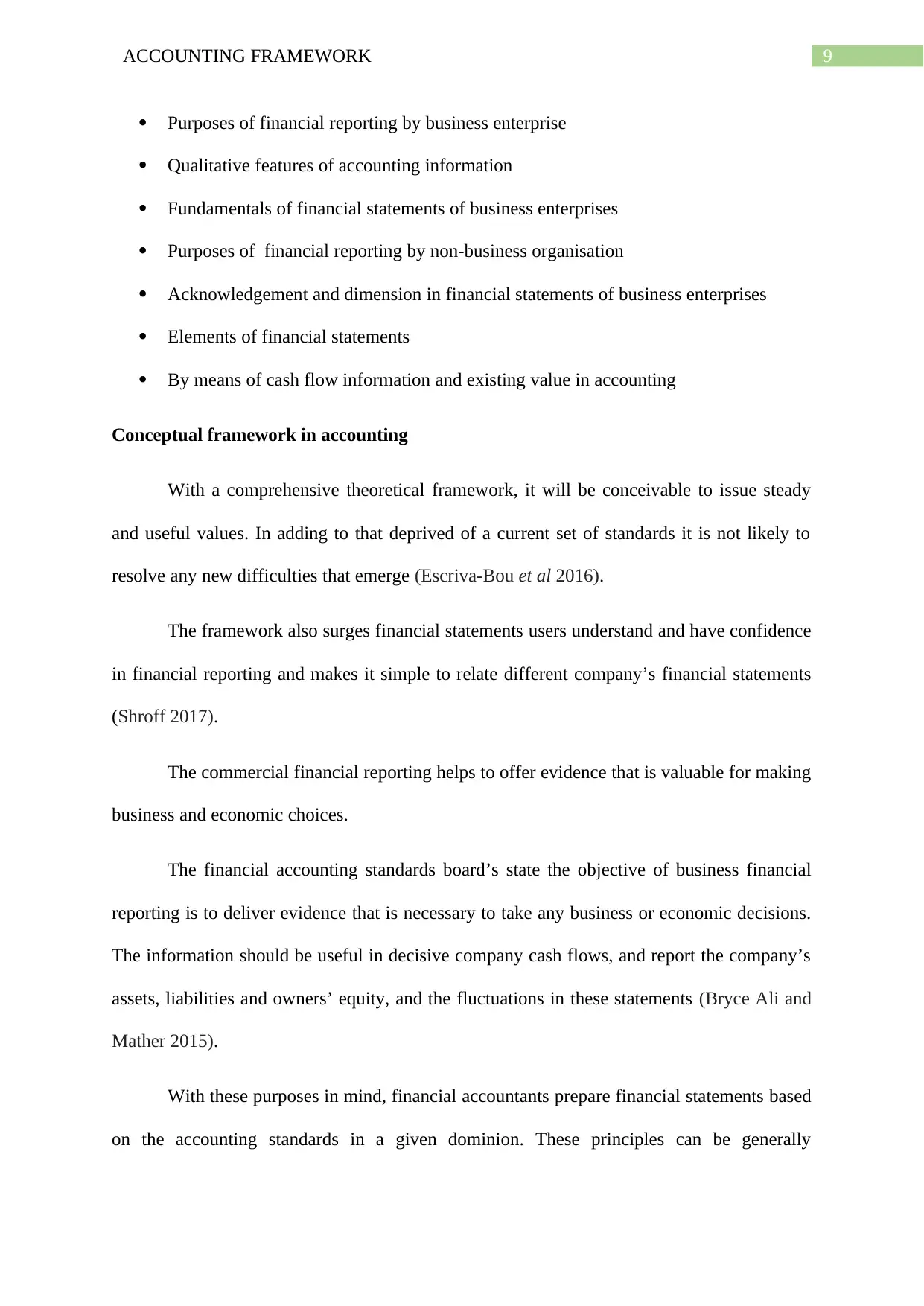
9ACCOUNTING FRAMEWORK
Purposes of financial reporting by business enterprise
Qualitative features of accounting information
Fundamentals of financial statements of business enterprises
Purposes of financial reporting by non-business organisation
Acknowledgement and dimension in financial statements of business enterprises
Elements of financial statements
By means of cash flow information and existing value in accounting
Conceptual framework in accounting
With a comprehensive theoretical framework, it will be conceivable to issue steady
and useful values. In adding to that deprived of a current set of standards it is not likely to
resolve any new difficulties that emerge (Escriva-Bou et al 2016).
The framework also surges financial statements users understand and have confidence
in financial reporting and makes it simple to relate different company’s financial statements
(Shroff 2017).
The commercial financial reporting helps to offer evidence that is valuable for making
business and economic choices.
The financial accounting standards board’s state the objective of business financial
reporting is to deliver evidence that is necessary to take any business or economic decisions.
The information should be useful in decisive company cash flows, and report the company’s
assets, liabilities and owners’ equity, and the fluctuations in these statements (Bryce Ali and
Mather 2015).
With these purposes in mind, financial accountants prepare financial statements based
on the accounting standards in a given dominion. These principles can be generally
Purposes of financial reporting by business enterprise
Qualitative features of accounting information
Fundamentals of financial statements of business enterprises
Purposes of financial reporting by non-business organisation
Acknowledgement and dimension in financial statements of business enterprises
Elements of financial statements
By means of cash flow information and existing value in accounting
Conceptual framework in accounting
With a comprehensive theoretical framework, it will be conceivable to issue steady
and useful values. In adding to that deprived of a current set of standards it is not likely to
resolve any new difficulties that emerge (Escriva-Bou et al 2016).
The framework also surges financial statements users understand and have confidence
in financial reporting and makes it simple to relate different company’s financial statements
(Shroff 2017).
The commercial financial reporting helps to offer evidence that is valuable for making
business and economic choices.
The financial accounting standards board’s state the objective of business financial
reporting is to deliver evidence that is necessary to take any business or economic decisions.
The information should be useful in decisive company cash flows, and report the company’s
assets, liabilities and owners’ equity, and the fluctuations in these statements (Bryce Ali and
Mather 2015).
With these purposes in mind, financial accountants prepare financial statements based
on the accounting standards in a given dominion. These principles can be generally
Paraphrase This Document
Need a fresh take? Get an instant paraphrase of this document with our AI Paraphraser
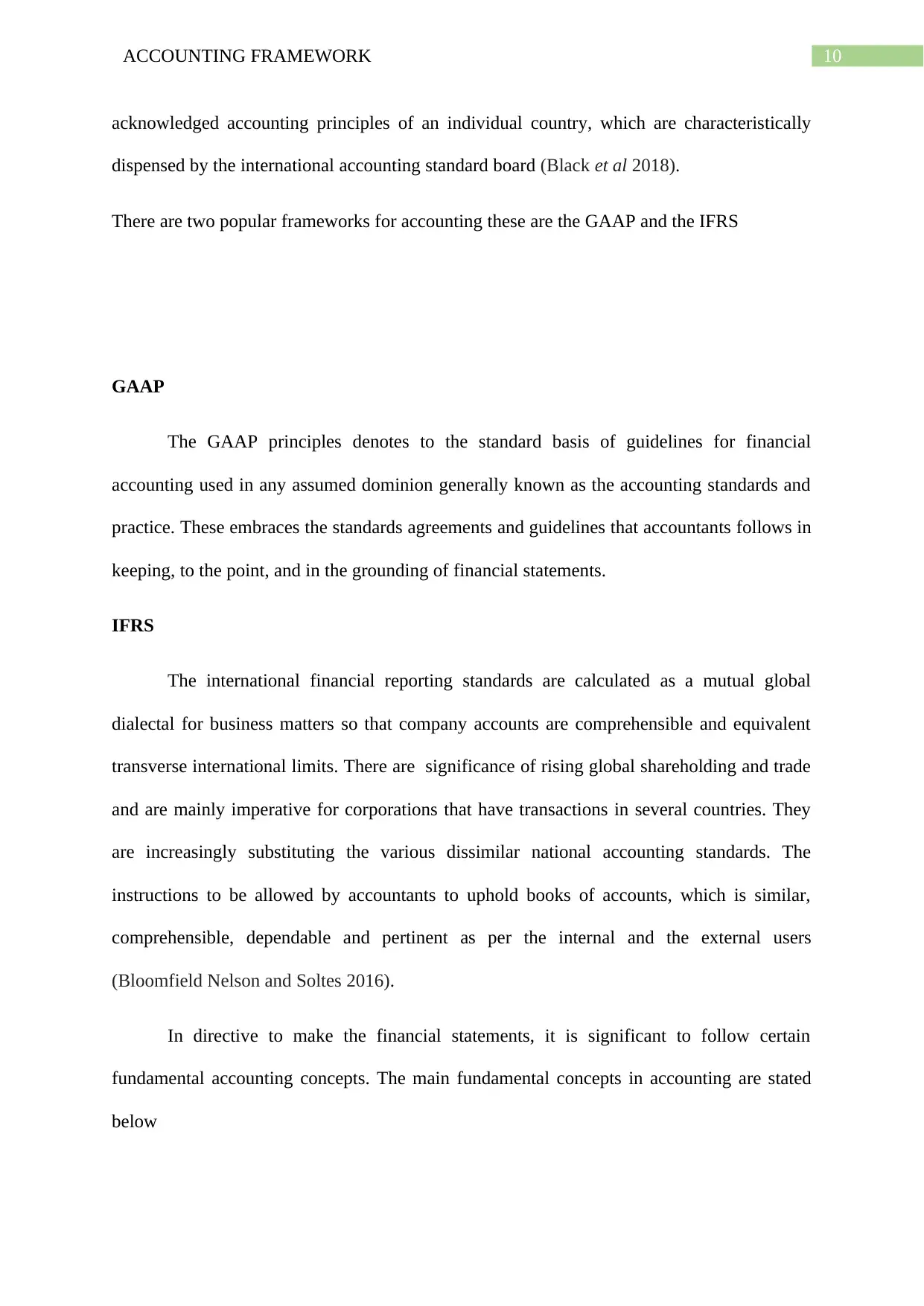
10ACCOUNTING FRAMEWORK
acknowledged accounting principles of an individual country, which are characteristically
dispensed by the international accounting standard board (Black et al 2018).
There are two popular frameworks for accounting these are the GAAP and the IFRS
GAAP
The GAAP principles denotes to the standard basis of guidelines for financial
accounting used in any assumed dominion generally known as the accounting standards and
practice. These embraces the standards agreements and guidelines that accountants follows in
keeping, to the point, and in the grounding of financial statements.
IFRS
The international financial reporting standards are calculated as a mutual global
dialectal for business matters so that company accounts are comprehensible and equivalent
transverse international limits. There are significance of rising global shareholding and trade
and are mainly imperative for corporations that have transactions in several countries. They
are increasingly substituting the various dissimilar national accounting standards. The
instructions to be allowed by accountants to uphold books of accounts, which is similar,
comprehensible, dependable and pertinent as per the internal and the external users
(Bloomfield Nelson and Soltes 2016).
In directive to make the financial statements, it is significant to follow certain
fundamental accounting concepts. The main fundamental concepts in accounting are stated
below
acknowledged accounting principles of an individual country, which are characteristically
dispensed by the international accounting standard board (Black et al 2018).
There are two popular frameworks for accounting these are the GAAP and the IFRS
GAAP
The GAAP principles denotes to the standard basis of guidelines for financial
accounting used in any assumed dominion generally known as the accounting standards and
practice. These embraces the standards agreements and guidelines that accountants follows in
keeping, to the point, and in the grounding of financial statements.
IFRS
The international financial reporting standards are calculated as a mutual global
dialectal for business matters so that company accounts are comprehensible and equivalent
transverse international limits. There are significance of rising global shareholding and trade
and are mainly imperative for corporations that have transactions in several countries. They
are increasingly substituting the various dissimilar national accounting standards. The
instructions to be allowed by accountants to uphold books of accounts, which is similar,
comprehensible, dependable and pertinent as per the internal and the external users
(Bloomfield Nelson and Soltes 2016).
In directive to make the financial statements, it is significant to follow certain
fundamental accounting concepts. The main fundamental concepts in accounting are stated
below
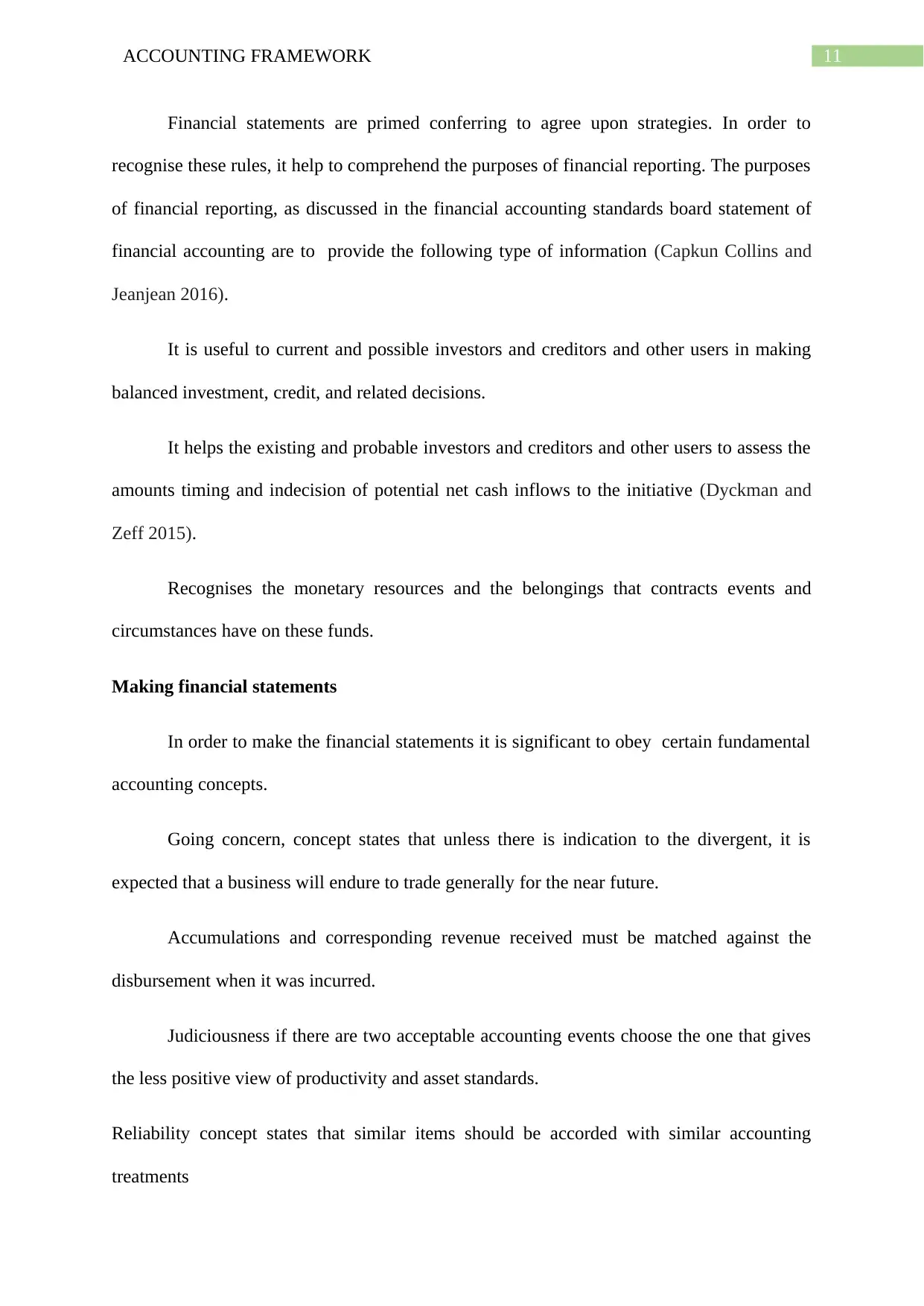
11ACCOUNTING FRAMEWORK
Financial statements are primed conferring to agree upon strategies. In order to
recognise these rules, it help to comprehend the purposes of financial reporting. The purposes
of financial reporting, as discussed in the financial accounting standards board statement of
financial accounting are to provide the following type of information (Capkun Collins and
Jeanjean 2016).
It is useful to current and possible investors and creditors and other users in making
balanced investment, credit, and related decisions.
It helps the existing and probable investors and creditors and other users to assess the
amounts timing and indecision of potential net cash inflows to the initiative (Dyckman and
Zeff 2015).
Recognises the monetary resources and the belongings that contracts events and
circumstances have on these funds.
Making financial statements
In order to make the financial statements it is significant to obey certain fundamental
accounting concepts.
Going concern, concept states that unless there is indication to the divergent, it is
expected that a business will endure to trade generally for the near future.
Accumulations and corresponding revenue received must be matched against the
disbursement when it was incurred.
Judiciousness if there are two acceptable accounting events choose the one that gives
the less positive view of productivity and asset standards.
Reliability concept states that similar items should be accorded with similar accounting
treatments
Financial statements are primed conferring to agree upon strategies. In order to
recognise these rules, it help to comprehend the purposes of financial reporting. The purposes
of financial reporting, as discussed in the financial accounting standards board statement of
financial accounting are to provide the following type of information (Capkun Collins and
Jeanjean 2016).
It is useful to current and possible investors and creditors and other users in making
balanced investment, credit, and related decisions.
It helps the existing and probable investors and creditors and other users to assess the
amounts timing and indecision of potential net cash inflows to the initiative (Dyckman and
Zeff 2015).
Recognises the monetary resources and the belongings that contracts events and
circumstances have on these funds.
Making financial statements
In order to make the financial statements it is significant to obey certain fundamental
accounting concepts.
Going concern, concept states that unless there is indication to the divergent, it is
expected that a business will endure to trade generally for the near future.
Accumulations and corresponding revenue received must be matched against the
disbursement when it was incurred.
Judiciousness if there are two acceptable accounting events choose the one that gives
the less positive view of productivity and asset standards.
Reliability concept states that similar items should be accorded with similar accounting
treatments
⊘ This is a preview!⊘
Do you want full access?
Subscribe today to unlock all pages.

Trusted by 1+ million students worldwide
1 out of 21
Related Documents
Your All-in-One AI-Powered Toolkit for Academic Success.
+13062052269
info@desklib.com
Available 24*7 on WhatsApp / Email
![[object Object]](/_next/static/media/star-bottom.7253800d.svg)
Unlock your academic potential
Copyright © 2020–2025 A2Z Services. All Rights Reserved. Developed and managed by ZUCOL.




